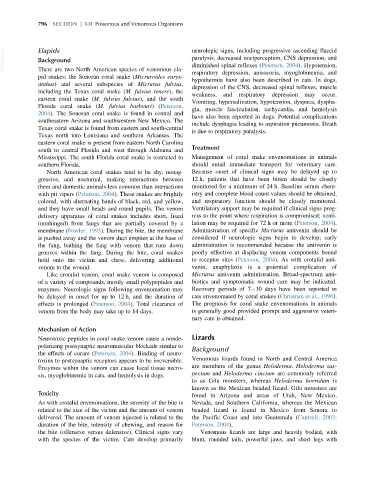Page 838 - Veterinary Toxicology, Basic and Clinical Principles, 3rd Edition
P. 838
796 SECTION | XII Poisonous and Venomous Organisms
VetBooks.ir Elapids neurologic signs, including progressive ascending flaccid
paralysis, decreased nociperception, CNS depression, and
Background
diminished spinal reflexes (Peterson, 2004). Hypotension,
There are two North American species of venomous ela-
pid snakes: the Sonoran coral snake (Micruroides euryx- respiratory depression, anisocoria, myoglobinemia, and
hypothermia have also been described in cats. In dogs,
anthus) and several subspecies of Micrurus fulvius,
depression of the CNS, decreased spinal reflexes, muscle
including the Texas coral snake (M. fulvius tenere), the
weakness, and respiratory depression may occur.
eastern coral snake (M. fulvius fulvius), and the south
Vomiting, hypersalivation, hypotension, dyspnea, dyspha-
Florida coral snake (M. fulvius barbouri)(Peterson,
gia, muscle fasciculation, tachycardia, and hemolysis
2004). The Sonoran coral snake is found in central and
have also been reported in dogs. Potential complications
southeastern Arizona and southwestern New Mexico. The
include dysphagia leading to aspiration pneumonia. Death
Texas coral snake is found from eastern and south-central
is due to respiratory paralysis.
Texas north into Louisiana and southern Arkansas. The
eastern coral snake is present from eastern North Carolina
Treatment
south to central Florida and west through Alabama and
Mississippi. The south Florida coral snake is restricted to Management of coral snake envenomations in animals
southern Florida. should entail immediate transport for veterinary care.
North American coral snakes tend to be shy, nonag- Because onset of clinical signs may be delayed up to
gressive, and nocturnal, making interactions between 12 h, patients that have been bitten should be closely
them and domestic animals less common than interactions monitored for a minimum of 24 h. Baseline serum chem-
with pit vipers (Peterson, 2004). These snakes are brightly istry and complete blood count values should be obtained,
colored, with alternating bands of black, red, and yellow, and respiratory function should be closely monitored.
and they have small heads and round pupils. The venom Ventilatory support may be required if clinical signs prog-
delivery apparatus of coral snakes includes short, fixed ress to the point where respiration is compromised; venti-
(nonhinged) front fangs that are partially covered by a lation may be required for 72 h or more (Peterson, 2004).
membrane (Fowler, 1993). During the bite, the membrane Administration of specific Micrurus antivenin should be
is pushed away and the venom duct empties at the base of considered if neurologic signs begin to develop; early
the fang, bathing the fang with venom that runs down administration is recommended because the antivenin is
grooves within the fang. During the bite, coral snakes poorly effective at displacing venom components bound
hold onto the victim and chew, delivering additional to receptor sites (Peterson, 2004). As with crotalid anti-
venom to the wound. venin, anaphylaxis is a potential complication of
Like crotalid venom, coral snake venom is composed Micrurus antivenin administration. Broad-spectrum anti-
of a variety of compounds, mostly small polypeptides and biotics and symptomatic wound care may be indicated.
enzymes. Neurologic signs following envenomation may Recovery periods of 7 10 days have been reported in
be delayed in onset for up to 12 h, and the duration of cats envenomated by coral snakes (Chrisman et al., 1996).
effects is prolonged (Peterson, 2004). Total clearance of The prognosis for coral snake envenomations in animals
venom from the body may take up to 14 days. is generally good provided prompt and aggressive veteri-
nary care is obtained.
Mechanism of Action
Neurotoxic peptides in coral snake venom cause a nonde- Lizards
polarizing postsynaptic neuromuscular blockade similar to
Background
the effects of curare (Peterson, 2004). Binding of neuro-
Venomous lizards found in North and Central America
toxins to postsynaptic receptors appears to be irreversible.
Enzymes within the venom can cause local tissue necro- are members of the genus Heloderma. Heloderma sus-
sis, myoglobinemia in cats, and hemolysis in dogs. pectum and Heloderma cinctum are commonly referred
to as Gila monsters, whereas Heloderma horridum is
known as the Mexican beaded lizard. Gila monsters are
Toxicity found in Arizona and areas of Utah, New Mexico,
As with crotalid envenomations, the severity of the bite is Nevada, and Southern California, whereas the Mexican
related to the size of the victim and the amount of venom beaded lizard is found in Mexico from Sonora to
delivered. The amount of venom injected is related to the the Pacific Coast and into Guatemala (Cantrell, 2003;
duration of the bite, intensity of chewing, and reason for Peterson, 2004).
the bite (offensive versus defensive). Clinical signs vary Venomous lizards are large and heavily bodied, with
with the species of the victim. Cats develop primarily blunt, rounded tails, powerful jaws, and short legs with

